The crucial cogs of AFL's Round 7: Which players need to be the difference makers?
We’re taking a look at one player from each team that needs to make a difference this week, starting with the ANZAC Day games.
Opinion
Still reeling from their horror 119-point loss to Geelong in the 2007 grand final, Port Adelaide entered the decade struggling for relevancy.
Premiership coach Mark Williams resigned after the Power slumped to a 5-10 record in 2010, bringing an end to his 274-game tenure. Former captain Matthew Primus took the reins as caretaker coach, steering Port to five wins from their last seven games. Despite the club proclaiming that they would be looking to hire someone with no past association with Port Adelaide, Primus’ impressive end to the season saw him handed the full-time role.
But the first full season under Primus was an unmitigated disaster. The Power won just three matches, their lowest since joining the AFL. They slumped to 17th with a beyond horrible percentage of 64.5, thanks largely in part to a two-game stretch where they lost by a combined 303 points.
2012 was only marginally more successful with five wins, but their average home crowds dropped under 20,000. After an inexcusable defeat at the hands of the GWS Giants late in the year, Primus stood down, departing with a winning percentage of just over 27. Garry Hocking took over, claiming a draw in the final round against Richmond.
The winds of change swept over Alberton heading into 2013, with Geelong assistant Ken Hinkley named the new coach and Travis Boak taking over from Domenic Cassisi as captain.
Finally, television personality David Koch was announced as the new chairman, with several board members departing. The breath of fresh air reinvigorated the club, with Hinkley leading Port Adelaide out of the mire and into their first finals campaign since 2007.
In an elimination final against a heavily-favoured Collingwood at the MCG, Port surprised again with a four-goal victory to set up a semi-final against Geelong. Despite leading by 23 points at halftime, the Power were overrun. Hinkley was then named the AFL Coaches Association’s coach of the year.
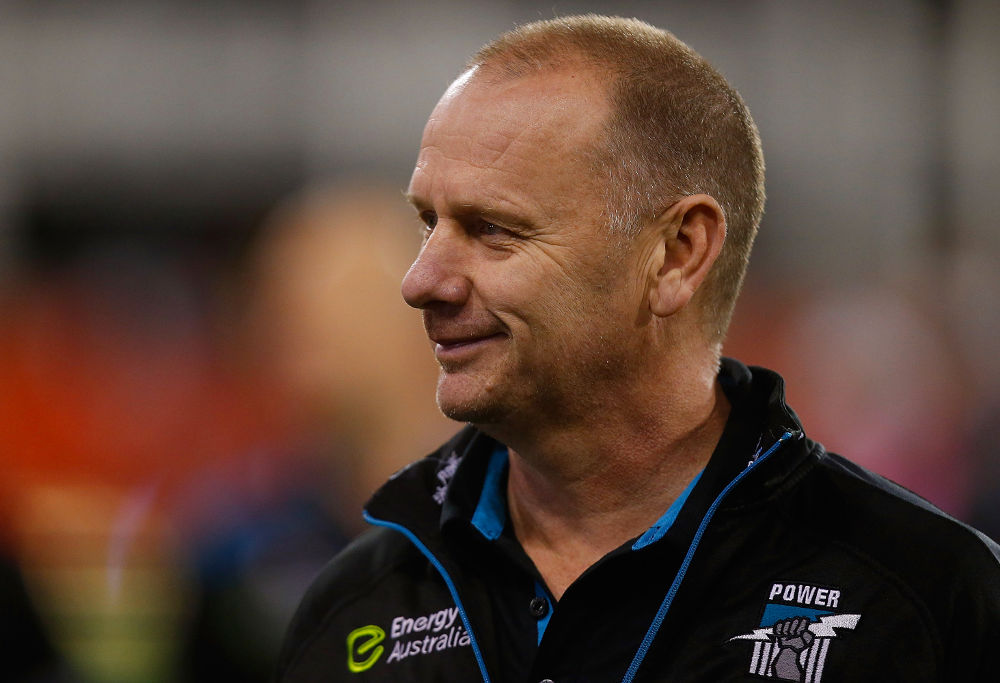
Power coach Ken Hinkley. (Photo by Chris Hyde/Getty Images)
Port had an even better 2014, winning 11 of their first 13 matches to be a genuine premiership contender. An indifferent end to the season saw them finish fifth, setting up a home final against Richmond. The Power stormed to a monster win over the Tigers, setting them up to travel west to face Fremantle a week later.
Trailing by four goals at halftime, they fought back in a dominant second half to win by 22 points, advancing to the preliminary final. Taking on reigning premiers Hawthorn, the Power again came back from the dead, fighting from 29 points down in the final quarter to fall just three points short.
A late-season surge saw the Power just miss out on a third consecutive finals campaign in 2015, and it was a similar story a year later, finishing tenth on the ladder after another underperformance.
Facing significant pressure for the first time in his coaching career, Hinkley responded by returning Port to September with a 14-win season in 2017. In a home final against West Coast, the two sides battled their into extra time. Despite jumping out to a 13-point lead, Port would be defeated with a kick after the siren from Luke Shuey.
The Power looked set to once again feature in the finals in 2018, sitting inside the top four after Round 19. However, a horror final month saw them fall out of the top eight altogether. Another stuttering season to finish the decade again saw them finish on the cusp of the top eight, seeing frustration with Hinkley’s coaching style grow among supporters.
Round 19, 2013 – Adelaide 15.13 (103) defeated by Port Adelaide 17.5 (107) (Football Park)
Arguably the best-ever Showdown was saved for the last one Football Park. Teetering inside the top eight and desperately needing a win, Port saw a 21-point halftime advantage disintegrate into a 20-point deficit late in the game. However, with the final four goals of the match, they snatched back the lead to claim a memorable victory.
Just days after turning 20 years old, Chad Wingard was named the Showdown medallist after kicking five goals from 24 disposals.
Elimination final, 2013 – Collingwood 9.9 (63) defeated by Port Adelaide 12.15 (87) (MCG)
Port were long odds to cause an upset against a Magpies side featuring a whopping 15 premiership players on their home deck. The Power, in contrast, had 15 on their side playing in a final for the first time. After holding the lead for majority of the night, Port looked set to be overrun in the last quarter. However, with the final four goals of the night, they steadied claim a four-goal victory in one of the biggest boilovers in finals footy.
Elimination final, 2014 – Port Adelaide 20.12 (132) defeated Richmond 11.9 (75) (Adelaide Oval)
In their first ever final at the Adelaide Oval, Port treated their fans to a truly dominant display, slamming on seven goals before the Tigers could even manage a score. Leading by 81 points in the final quarter, they could have gone on to register one of the biggest finals victories, but instead took their foot off the pedal to end up with a very convincing 57-point triumph.
Round 5, 2011 – Port Adelaide 15.11 (101) defeated by Gold Coast 15.14 (104) (Football Park)
After losing their opening three matches by an average of 57 points, Port had a golden opportunity to bank two consecutive wins when they took on the AFL’s newest side in the Gold Coast Suns.
Things appeared to be going to plan, with the Power skipping away to a 40-point lead late in the third quarter. However, the Suns, who were on the back of three losses by a combined 280 points, fought back to incredibly snatch the lead.
With one final thrust forward, Justin Westhoff marked inside 50, but his kick after the siren went wide, giving the Suns their first ever win and consigning Port to an embarrassing 1-4 start.
Round 21, 2011 – Hawthorn 31.11 (197) defeated Port Adelaide 5.2 (32) (MCG)
Fresh off an embarrassing 138-point annihilation at the hands of Collingwood, the Power had the unenviable task of taking on a top-four outfit in Hawthorn.
With young prodigy John Butcher playing his first game, alongside a relatively no-name defender Tom Jonas, the Power were thrown to the wolves as the Hawks piled on 17 goals before halftime.
The pain didn’t relent after the main break, with Port conceding the club’s highest-ever score in the AFL, while the eventual margin of 165 points was the largest ever recorded since they entered the league in 1997, and the second-biggest loss by any side in the decade.
Round 20, 2017 – Adelaide 18.22 (130) defeated Port Adelaide 7.4 (46) (Adelaide Oval)
Sitting just outside the top four, the Power came face-to-face with their bitter rivals in a late-season Showdown. With both sides almost assured of playing finals, it was billed as a contest not to be missed. However, the top-of-the-ladder Crows, despite a scrappy start, cruised to a monster 84-point win in the most one-sided Showdown ever.
Port managed a measly 11 scoring shots for the evening, with the Crows piling on 40 of their own in a performance Hinkley labelled “unacceptable”.
Rebranding
In 2007, the club began engaging with children from their ‘Planet Teal’ supporters program to design special one-off guernseys to wear in one match during the season.
In 2009, seven-year-old Lucy Burford designed a predominantly black jumper with teal and white chevrons, which garnered so much positivity from members that the club decided to rebrand and wear it full time, starting in 2010.
The death of John McCarthy
The Power were rocked at the end of the 2012 season, when first-year midfielder John McCarthy tragically lost his life during an end-of-season trip to Las Vegas.
McCarthy was recruited after being delisted by Collingwood following 18 games over four seasons. He enjoyed a strong opening campaign in the Power colours, playing 21 matches and establishing himself in the best 22.
Only a few hours after checking in to the Flamingo Hotel, McCarthy reportedly tried jumping from the roof of the hotel to a palm tree, but ended up falling to his death. It was an incredibly sombre start to a summer of change for the Power.
Move to the Adelaide Oval
At the start of the decade, Port were in severe strife, both on and off the field. Just eight wins across the 2011 and 2012 seasons saw the club infamously forced to use black tarps to cover large portions of empty seats.
In 2012, the Adelaide Oval was significantly upgraded, allowing the Power and Crows to play their home games their from 2014. Centralised access to the venue from the Adelaide CBD (compared to Football Park out in the suburbs) and a dramatic increase in form in 2013 saw the Power became a hot ticket item, averaging crowds of just under 44,000 over 2014 and 2015, while their membership number grew to more than 55,000.
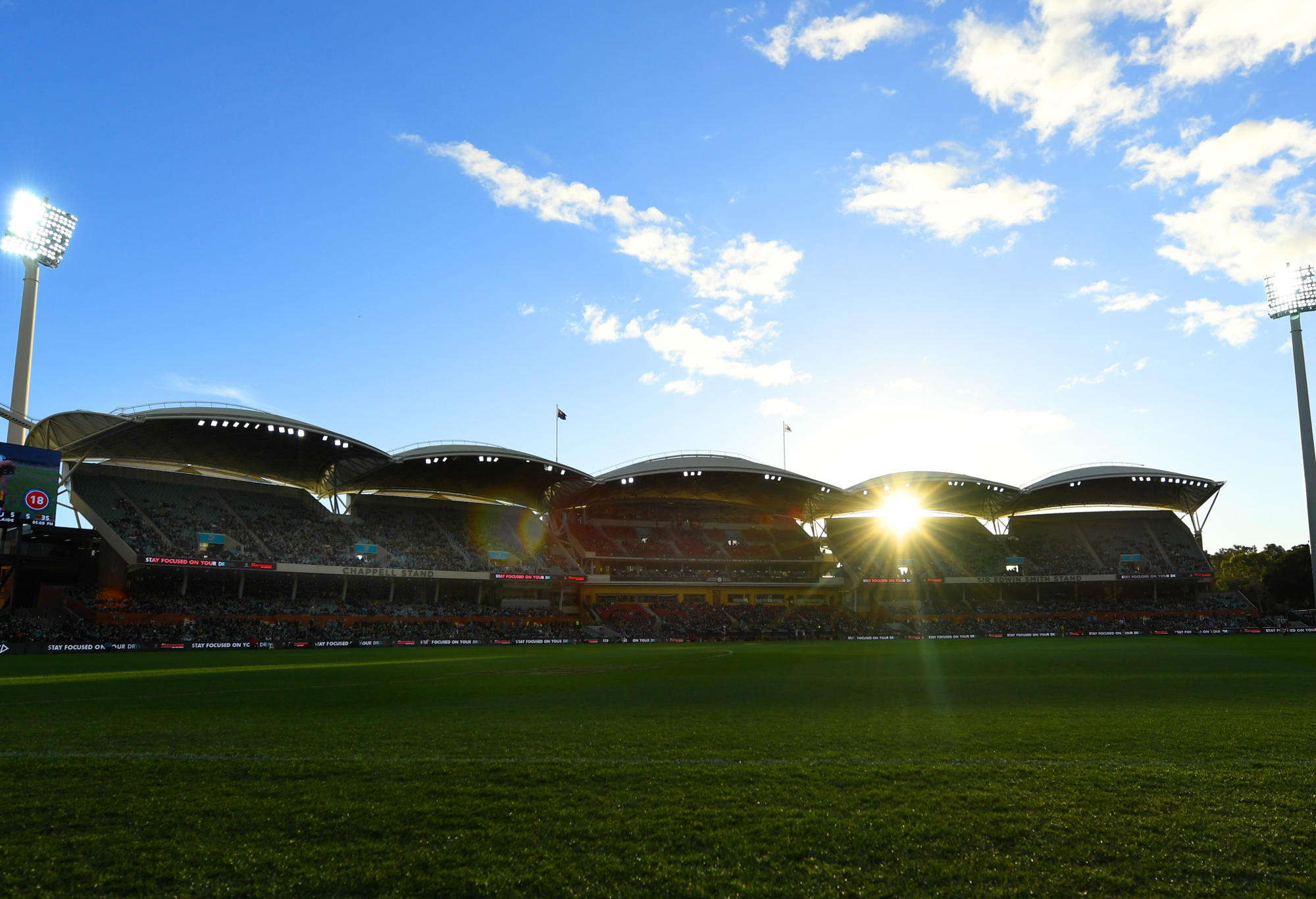
The Adelaide Oval has been a boon for footy in South Australia. (Photo by Mark Brake/Getty Images)
Back pocket – Tom Jonas
Life as an AFL footballer didn’t get off to a good start for Jonas, with the rookie debuting in the record 165-point loss to Hawthorn in 2011. He didn’t let the tough introduction affect his footy though, going on to establish himself in the backline in 2013.
After a tough 2016 that saw him suspended for six matches following an ugly hit on Andrew Gaff, Jonas responded with a top-three placing in the John Cahill medal in 2017, before claiming second spot a year later. Heading into 2019, Jonas was appointed co-captain, but was named the sole skipper ahead of 2020.
Full back – Alipate Carlile
A reliable defender, Carlile enjoyed a strong 2010, finishing third in the club best and fairest. He played 114 games in the decade, before retiring in 2016.
Back pocket – Jasper Pittard
One of three players taken by the club in the first round of the 2009 draft, Pittard took a while to get his body up to the rigours of AFL football, playing 14 matches over his first three seasons.
He broke into the line-up in 2013, eradicating the occasional brain fades that had crept into his game. In 2016, Pittard was the only Power player nominated in the All Australian squad of 40, but he did not make the final team, ending up with a top-three placing in the John Cahill medal. Fell out of favour in 2018, leading to a trade to North Melbourne after 126 matches.
Half-back – Hamish Hartlett
Arrived with plenty of expectation given he was the club’s highest-ever draft selection. After being named best first-year player in his debut season, Hartlett was cruelled by quad and hamstring injuries in 2010, restricting him to just four matches. Fought back to be a solid contributor under Primus, before playing his best football as Hinkley came onboard.
Hartlett achieved top ten finishes in each of the 2013, 2014 and 2015 seasons playing mostly as a midfielder. In 2016, Hartlett was named vice-captain, but a torn ACL in 2018 saw him miss over a year. He finished the decade with a respectable 153 games and 68 goals.
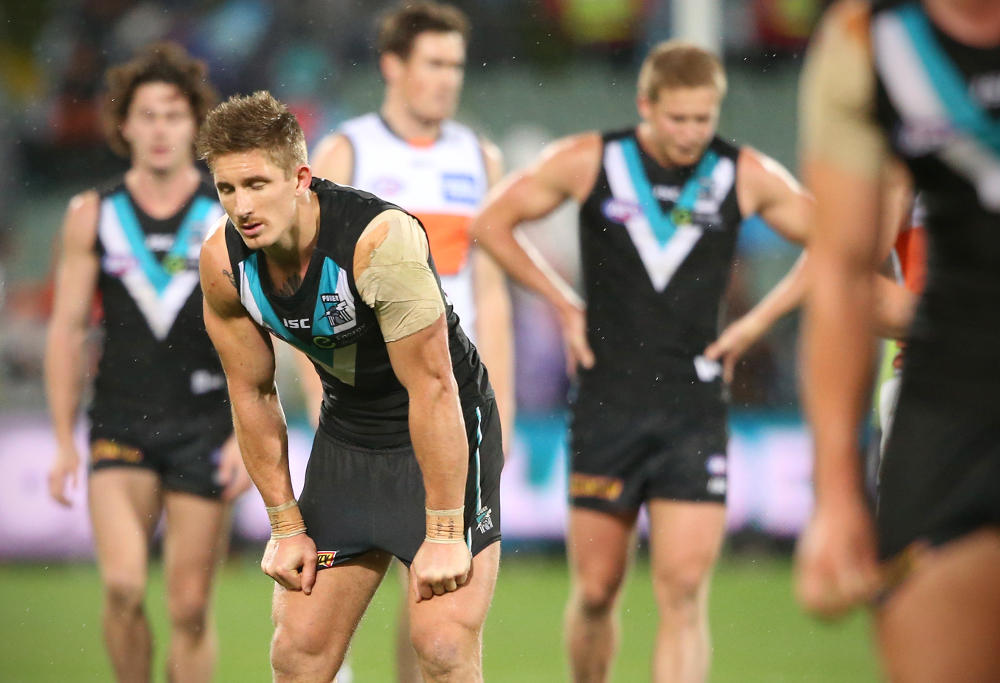
Hamish Hartlett (L). (AAP Image/Ben MacMahon)
Centre half-back – Jackson Trengove
Following on from an impressive debut season in 2010, in which he was awarded the Gavin Wanganeen medal as Port’s best player under the age of 21, Trengove was a joint winner of the club best and fairest in 2011.
A reliable defender capable of playing in the ruck, Trengove remained a steady contributor as Port improved under Hinkley, battling injury at times. Trengove spent the majority of 2017 playing up forward, resulting in a career-best 17 goals, however, he departed for the Western Bulldogs following 153 games.
Half-back – Matthew Broadbent
A member of the new generation entering the decade, Broadbent showed his immense promise early with an equal-second finish in the John Cahill medal in 2012, playing as a two-way midfielder.
Following his impressive campaign, Broadbent found his niche as a rebounding defender, featuring prominently in Port’s rise up the ladder in 2013 and 2014. He continued to be a steady hand in the backline before he missed 2018 due to ankle and toe injuries. Returned to feature in 10 games in 2019, but was surprisingly delisted after 168 games and 49 goals in the decade.
Wing – Brad Ebert
The nephew of Port Adelaide champion Russell, Ebert began his career with West Coast, spending four seasons as an Eagle before requesting a trade at the end of 2011. Ebert quickly became a key member of the midfield, finishing equal-second in the John Cahill medal. He followed it up with another top-five finish a year later in what was his first season as vice-captain, impressing with his durability.
In 2016, Ebert missed his first game through injury since joining the Power, before polling a career-best 15 Brownlow medal votes a year later. A knee injury and concussion issues saw Ebert miss half of 2019, finishing the decade with 170 games and 96 goals.
Centre – Ollie Wines
A highly-rated midfielder from Echuca, Wines joined the club in the 2012 draft as a top-ten selection. He enjoyed a strong debut season, finishing third in the rising star award. 2014 would be the first of five consecutive top-ten finishes in the club best and fairest, coming runner-up in 2016. A year later, he polled a career-high 18 Brownlow medal votes, finishing eighth in the count.
After recommitting for an extra four years in 2018, Wines was announced as co-captain ahead of 2019 alongside Jonas. However, after a poor year, injuries and rumours he wanted a move back to Victoria, he was demoted to vice-captain for 2020 and beyond.
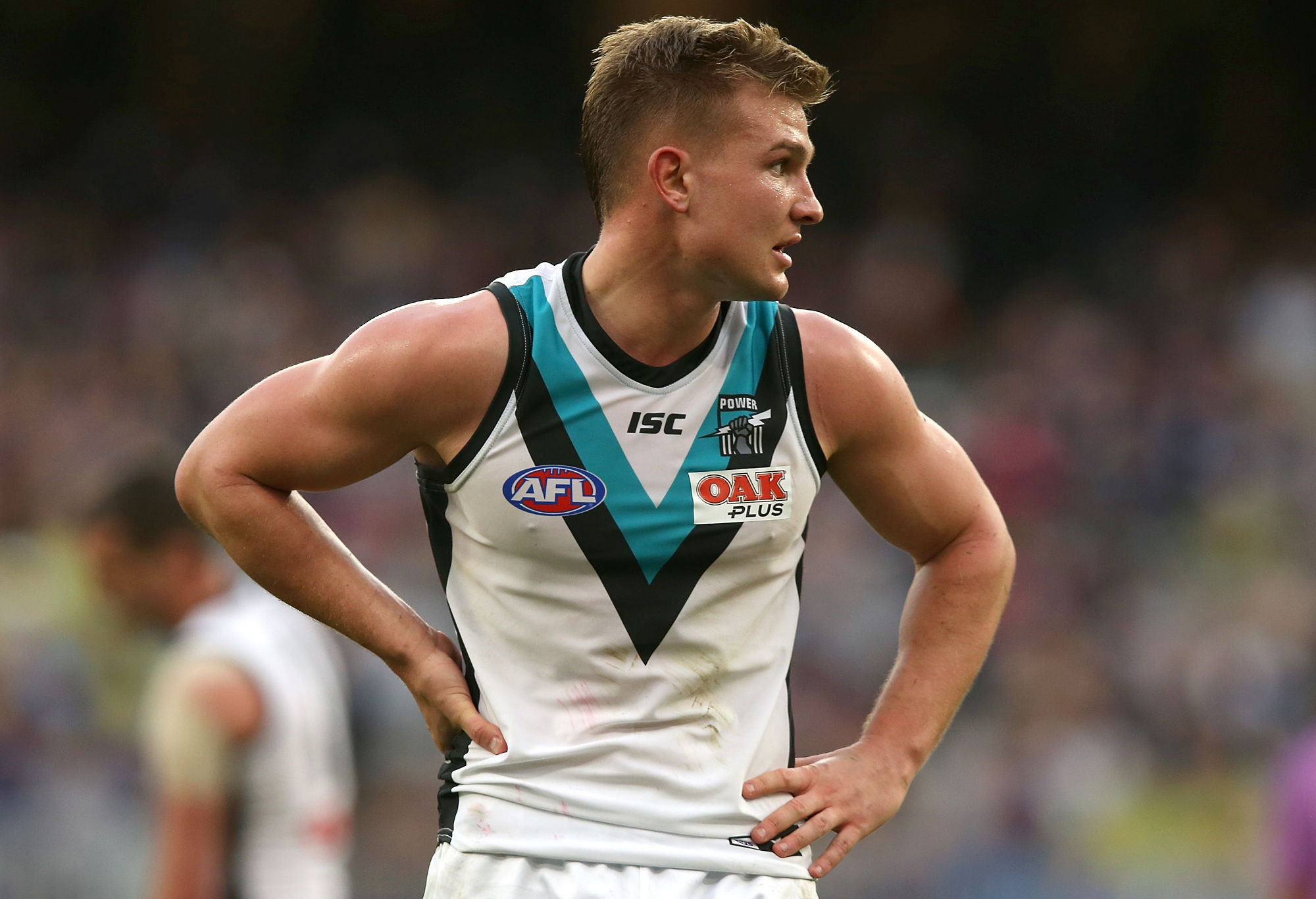
(Photo by Paul Kane/Getty Images)
Wing – Jared Polec
A top-five draft selection from 2010, Polec sought a trade in 2013 after three seasons with Brisbane. It resulted in a breakout campaign, establishing himself as a line-breaking midfielder capable of pushing forward to kick goals.
After missing the majority of 2015 due to stress fractures in his foot, Polec bounced back to his dangerous best, having a career-best season in 2018 that saw him finish fifth in the John Cahill medal. However, at the end of that campaign, Polec requested a trade to North Melbourne, departing after 90 matches and 46 goals.
Half-forward – Chad Wingard
Acquired early in the 2011 draft after a horrific season, Wingard showed his immense potential early, winning the Gavin Wanganeen medal in his debut year.
Wingard became the youngest-ever player to win the John Cahill medal in the AFL era in 2013, as well as earning All Australian selection as a freshly-turned-20-year-old after a 43-goal season.
After booting another haul of 43 majors in 2014 – as well as winning mark of the year – Wingard led the club goalkicking for the first time in 2015 with 53 majors, finishing eighth in the Coleman medal and earning All Australian honours for a second time.
After becoming a full-time midfielder in the latter years of the decade, Wingard surprisingly sought a trade, joining Hawthorn after 147 games and 232 goals.
Centre half-forward – Charlie Dixon
One of the members of the inaugural Gold Coast side, Dixon joined at the end of 2015 via a trade. After a promising start to his Power career, Dixon won Port’s goalkicking award in 2017 with a career-high haul of 49 majors. A broken leg suffered late in 2018 saw Dixon miss almost a whole year, as he enters the new decade looking to add to his 70 games and 118 goals.
Half-forward – Robbie Gray
Arguably Port’s greatest young talent entering the decade, Gray had an injury-interrupted 2010, playing just 11 games, however he would win his first Showdown medal that year after a five-goal haul.
Gray won the club goalkicking award in 2011 after booting 32 goals, but he would play just two games in 2012 following a horrific knee injury.
After finding his feet back at the top level in 2013, Gray won the first of three consecutive John Cahill medals in 2014, stamping himself as one of the league’s absolute best, highlighted by winning the AFLCA player of the year award and earning four selections in the All Australian team over a five-year period.
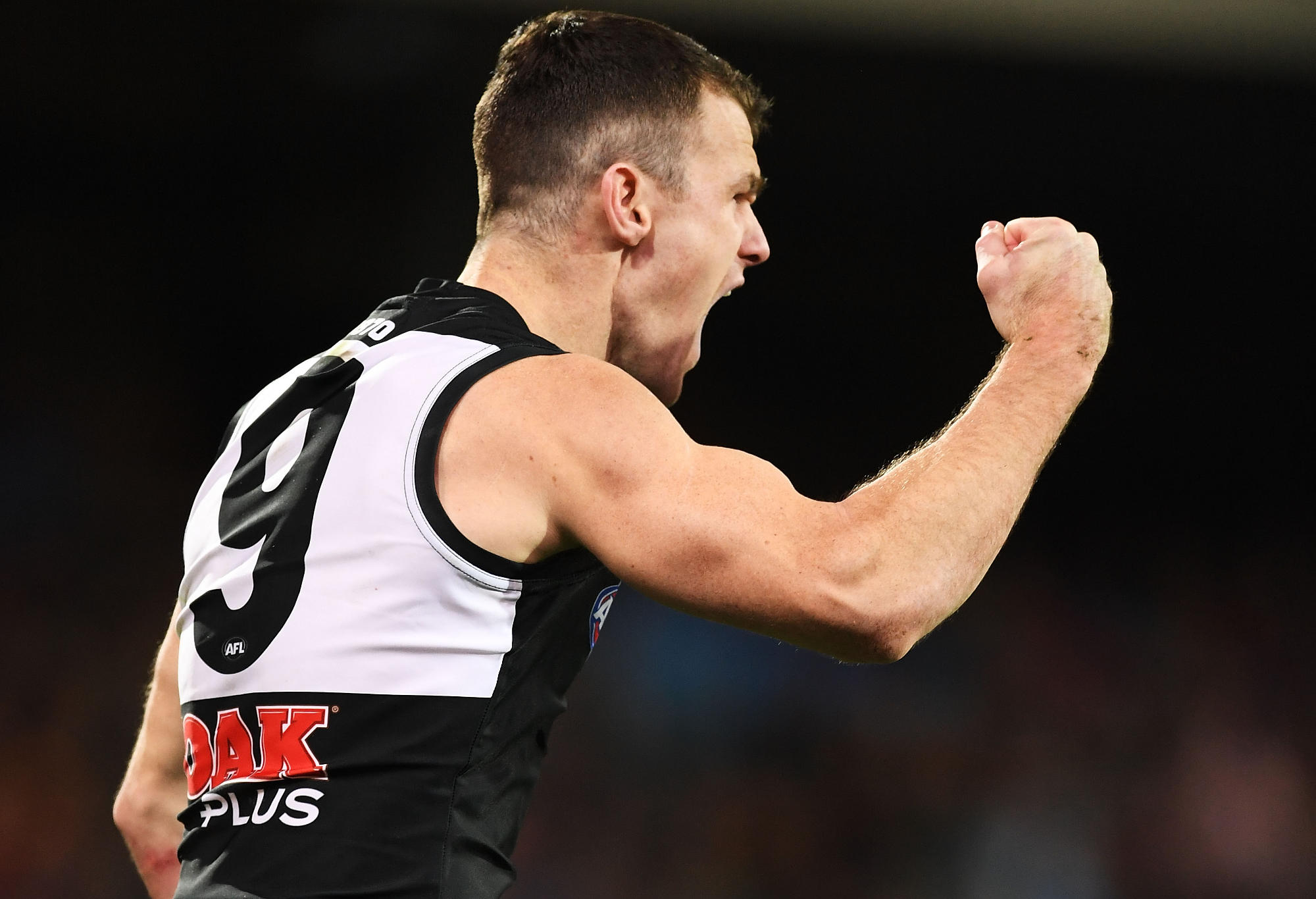
(Photo by Mark Brake/Getty Images)
Another leading goalkicker gong in 2018 was followed by a record fifth Showdown medal in 2019. After a decade that yielded 183 games and 166 goals, there is a genuine argument that Gray is the greatest player to pull on the Port Adelaide jumper since they joined the AFL.
Forward pocket – Justin Westhoff
Another highly talented youngster entering the new decade. After making a name for himself as a capable goalkicker, Westhoff spent the 2010 season playing through the ruck, resulting in a drop in his scoring output.
He improved in 2011 to finish equal-fifth in the John Cahill medal, before developing into a reliable Mr Fix-It, able to play almost anywhere on the field. This versatility saw him win his first best and fairest award in 2018. But it’s up forward where Westhoff remains the most dangerous, kicking 227 goals from 218 games in the decade.
Full forward – Jay Schulz
The highly-skilled but inconsistent Schulz joined at the end of 2009 after spending seven seasons with Richmond. The move paid enormous dividends for Schulz, who won four club goalkicking awards in his first five years with the Power.
After breaking into the top ten of the Coleman medal for the first time in 2013, Schulz enjoyed a remarkable 2014, booting a whopping 66 goals and finishing the home-and-away season in equal-second position. After topping over 40 goals for a fourth consecutive year in 2015, Schulz endured an injury-interrupted 2016, with Port choosing not to renew his contract after 123 games and 275 goals.
Forward pocket – Angus Monfries
A handy goalkicker in his time at Essendon, Monfries joined for the 2013 season and instantly became one of the Power’s most potent attacking options with a career-best 39 goal haul.
His form dipped significantly in the years after, but he still managed to add 44 goals over a two-year period. Monfries was suspended for the entire 2016 campaign due to his involvement in the Bombers’ supplements scandal, playing only one match upon his return.
Ruckman – Paddy Ryder
After seeking a trade away from the Bombers, Ryder joined Port at the end of 2014. He led the ruck division with aplomb in his first year, but was forced out of the game for one season due to his involvement in Essendon’s doping saga.
Ryder enjoyed a career-best year upon his return, taking out the John Cahill medal and earning selection in the All Australian team. Ryder remained a strong performer in 2018, but found himself out of form and in the SANFL in 2019, leading to him requesting a trade back to Victoria after 73 games and 54 goals.
Ruck-rover – Kane Cornes
It was an outstanding start to the decade for Cornes, who won his third John Cahill medal in 2010. However, he found himself on the outer just a year later and was demoted to the SANFL, ending a streak of 174 consecutive games.
Cornes responded with another strong campaign in 2012, equalling Warren Tredrea with a fourth AFL-era best and fairest. He played a key role under Hinkley as the Power surged up the ladder, but decided to retire early in the 2015 season after reaching his 300th game.
Rover – Travis Boak
Boak entered 2010 as the reigning Gavin Wanganeen medallist, and it didn’t take long for the midfielder to stamp himself as a genuine star of the competition, finishing in the top ten of the Brownlow medal.
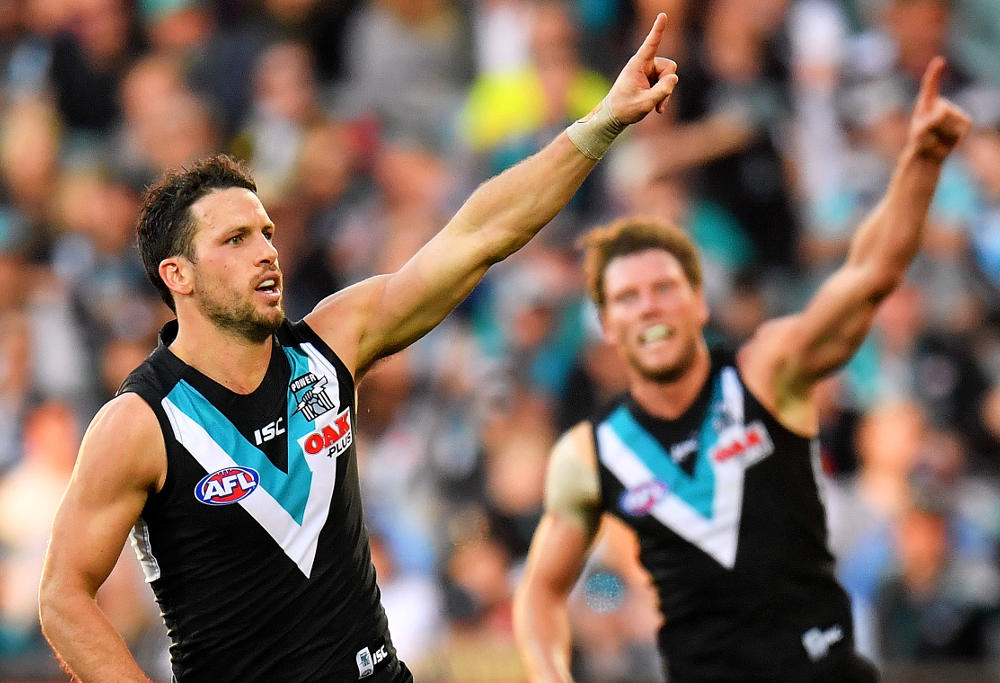
Travis Boak (L). (Photo by Daniel Kalisz/Getty Images)
In 2011, Boak was an equal-winner of the John Cahill medal, leading to his appointment as captain in 2013. It resulted in career-best football, as Boak was named in the All Australian side in both 2013 and 2014.
In each of those seasons, he came runner-up in the best and fairest, falling just five votes short of claiming the Brownlow in 2014.
After spending time playing on the half-forward line, Boak relinquished the captaincy and returned to a full-time midfield position in 2019, resulting in a second best and fairest. Boak played 215 games and kicked 151 goals throughout a stellar decade.
Interchange – Tom Clurey
A tall defender known for his endurance, Clurey debuted in the opening round of 2014, but had to wait over a year to add to that total.
It took until 2017 for Clurey to announce himself as a member of the best 22, becoming one of Port’s most reliable defenders. After breaking into the top ten of the John Cahill medal in 2018, Clurey finished fifth in the award after playing all but one game in 2019.
Interchange – Aaron Young
After a stuttering start to his career, Young enjoyed a breakout year in 2016 with 21 games and 37 goals as a handy contributor up forward – as well as claiming a top ten finish in the best and fairest. At the end of 2017, Young was traded to Gold Coast after 76 games and 62 goals.
Interchange – Darcy Byrne-Jones
After being drafted in 2013, Byrne-Jones was forced to wait until 2016 to make his debut, but he quickly endeared himself to the Power faithful with his no-fear attack on the ball.
After two top-ten finishes in the John Cahill medal from his first three years, Byrne-Jones broke out in 2019 with a runner-up finish.
Interchange – Sam Gray
After starting out his career with the SANFL side, Gray earned elevation to the senior team via the rookie draft. After making a name for himself as a handy ball-winning midfielder, Gray began playing predominantly as a small forward in 2017, kicking 69 goals over a three year period. After 96 games and 83 majors with the Power, Gray was delisted at the end of 2019 before signing with Sydney.
Off the field, Port are a completely different club. Membership numbers have surpassed 60,000 and they regularly attract home crowds in the vicinity of 35,000.
On the field, Port are flaky. They’re approaching six years since their last finals win, and the pressure is mounting on Hinkley, quite similarly to how Mark Williams was under the pump heading into 2010 – a campaign which he would not see the end of.
Talk from Koch last year indicated Hinkley would lose his job if Port didn’t qualify for finals in 2020, however, the COVID-19 pandemic probably gives him a hall pass this year.
The Power entered the decade with the likes of Boak, Gray, Westhoff and Hartlett entering their prime. Fast forward ten years, and the likes of Connor Rozee, Xavier Duursma, Todd Marshall and Zak Butters are leading the youth brigade.
Port supporters will have everything crossed that they don’t lose two to three of their best years just like their predecessors did during the Primus era.